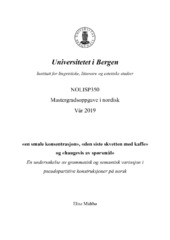| dc.contributor.author | Midtbø, Elise | |
| dc.date.accessioned | 2019-04-02T12:01:04Z | |
| dc.date.available | 2019-04-02T12:01:04Z | |
| dc.date.issued | 2019-03-23 | |
| dc.date.submitted | 2019-03-22T23:00:02Z | |
| dc.identifier.uri | https://hdl.handle.net/1956/19268 | |
| dc.description.abstract | This thesis presents a corpus-based investigation of grammatical and semantic variation in pseudopartitive constructions in Norwegian. Pseudopartitive constructions are binominal constructions where the first noun (the quantifying noun) designates an amount, and the second noun (the substance noun) designates a quantified substance, as in English a dose of antibiotics, a shoal of fish and a group of people. In Norwegian, pseudopartitive constructions can be expressed in three different ways: 1) by juxtaposing the two nouns (en gruppe mennesker, lit. ‘a group people’), 2) with the preposition av (en gruppe av mennesker, lit. ‘a group of people), or 3) with the preposition med (en gruppe med mennesker, lit. ‘a group with people’). The problem to be addressed is: What determines which of the three pseudopartitive construction types, juxtaposition, av or med, is used in Norwegian? To answer this, the study examines 31 highly frequent quantifying nouns and a total of 12,750 examples obtained from the balanced written corpus Leksikografisk bokmålskorpus. Based on previous research (Kinn, 2001 and Koptjevskaja.Tamm, 2001) It is investigated whether the following variables can explain the choice of construction type in Norwegian: 1) the semantic classification of the quantifying noun, 2) semantic properties of the substance noun (countable vs. mass and concrete vs. abstract), and 3) phrasal construction type (number and form of the quantifying noun, as well as determiners and adjectives in the phrase). It is observed that the choice of construction type to some extent correlates with the variables mentioned. Therefore, the construction types are arguably not randomly chosen, but motivated. Based on a cognitive approach to grammar (Heine 1997, Lakoff, 1987) It is suggested that the variation between av vs. med can be explained with reference to two schemas that reflect the conceptualization of the relation between the quantifying noun and the substance noun: an object constituted by a material (X av Y) and a container with a content (X med Y). The study also observes a tendency for quantifying nouns with a high frequency with the juxtapositional construction type to be used in a way that approaches functional words. These quantifying nouns exhibit expansion to new contexts (can categorize over different types of substance nouns), categorize quantitatively over the substance noun, can be replaced by much or many, and designate "bad" objects in the real world. This can be shown with the quantifying nouns masse (mass) and rekke (row) in the constructions en masse hodebry (a lot of headaches) and en rekke eksempler (a number of examples). It is argued that this phenomenon can be explained with reference to grammaticalization theory (Hopper and Traugott, 2003), and that the juxtapositional construction type is to some extent related to grammaticalization of the quantifying noun in Norwegian. | en_US |
| dc.description.abstract | Pseudopartitive konstruksjoner er binominale mengdeuttrykk der det første substantivet (målssubstantivet) kategoriserer over mengden (og/eller typen) masse som indikeres av det andre substantivet (artssubstantivet), slik som i en dose med antibiotika, en stim av fisk eller en gruppe mennesker. På norsk kan pseudopartitive konstruksjoner uttrykkes på tre forskjellige måter: 1) med jukstaponering av de to substantivene (en flokk mennesker), 2) med preposisjonen av (en flokk av mennesker), eller 3) med preposisjonen med (en flokk med mennesker). Oppgavens problemstilling er: Hva er det som bestemmer hvilken av de tre pseudopartitive konstruksjonstypene, jukstaposisjon, av og med, som tas i bruk på norsk? Materialet er basert på 31 frekvente målssubstantiv og består av totalt 12 750 treff hentet fra det vektede korpuset Leksikografisk bokmålskorpus. Med utgangspunkt i tidligere forskning (blant andre Kinn, 2001 og Koptjevskaja.Tamm, 2001) undersøkes det om målssubstantivets semantiske gruppetilhørighet, artssubstantivets semantiske egenskaper (tellelig vs. masse og konkret vs. abstrakt) og frasekategori (målssubstantivets tall og bestemthet, samt fravær eller tilstedeværelse av determinativ og adjektiv i frasen) kan forklare valget av konstruksjonstype. I analysen blir det vist at valget av konstruksjonstype i noen grad korrelerer med de nevnte variablene, og det argumenteres for at konstruksjonstypene ikke er tilfeldige, men motiverte. Med utgangspunkt i en kognitiv tilnærming til grammatikk (blant andre Heine 1997, Lakoff, 1987) foreslås det at variasjonen av vs. med kan forklares med utgangspunkt i to språklige skjemaer som speiler konseptualiseringen av relasjonen mellom målssubstantivet og artssubstantivet: en beholder med et innhold og et objekt konstituert av et materiale. Det blir også observert en tendens til at enkelte målssubstantiv med høy frekvens med jukstaposisjon brukes på en måte som nærmer seg funksjonsord. Disse målssubstantivene har stor utstrekning (kan opptre med ulike typer AS), kategoriserer kvantitativt over artssubstantivet, kan erstattes av mye eller mange, og har en «dårlig» referent i den virkelige verden, slik som masse og rekke i en masse hodebry og en rekke eksempler. Dette blir forklart med utgangspunkt i grammatikaliseringsteori, og det kan hevdes at konstruksjonstypen jukstaposisjon i noen grad henger sammen med grammatikalisering av målssubstantivene. | en_US |
| dc.language.iso | nob | eng |
| dc.publisher | The University of Bergen | eng |
| dc.title | "en smule konsentrasjon", "den siste skvetten med kaffe" og "haugevis av spørsmål": En undersøkelse av grammatisk og semantisk variasjon i pseudopartitive konstruksjoner på norsk | eng |
| dc.title.alternative | A corpus-based investigation of grammatical and semantic variation in pseudopartitive constructions in Norwegian. | eng |
| dc.type | Master thesis | |
| dc.date.updated | 2019-03-22T23:00:02Z | |
| dc.rights.holder | Copyright the Author. All rights reserved | eng |
| dc.description.degree | Mastergradsoppgave i nordisk språk og litteratur | |
| dc.description.localcode | NOLISP350 | |
| dc.subject.nus | 711123 | eng |
| fs.subjectcode | NOLISP350 | |
| fs.unitcode | 11-21-0 | |
